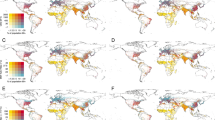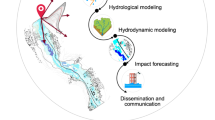Abstract
Midnight-to-midnight average pollutant concentration has been widely used as the exposure index in many epidemiological studies. This index, however, does not take account of the variability of time of death, because it simply takes 24-h average concentration from midnight to midnight, and this is equivalent to assuming that all deaths happened at the end of the day. This assumption is clearly inappropriate in the real situation, and might be a significant information bias in the exposure assessment. In order to take account of the variability of time of death, a new exposure index, the number-of-death-weighted 24-h average, is introduced in this study. This new index is calculated for each subject by taking 24-h average concentration preceding the time of death. In this study, this new index is applied to the suspended particulate matter (SPM) exposure assessment in Japan, and compared with the result obtained from the conventional index, the midnight-to-midnight average. There are quite large differences in the SPM average concentration between these two indices. Moreover, risk ratio calculated by the new index at time lag 0, where the mortality data and the average concentration data on the same day are used, is a lot larger than that obtained by the conventional one. In addition to the difference in its magnitude, time lag structure (from 1–5 days) also shows the different patterns between these two indices. This study suggests that the conventional exposure index, the midnight-to-midnight average, may evaluate the risk of SPM incorrectly, because of its inadequacy of capturing the temporal variability.
This is a preview of subscription content, access via your institution
Access options
Subscribe to this journal
Receive 6 print issues and online access
$259.00 per year
only $43.17 per issue
Buy this article
- Purchase on Springer Link
- Instant access to full article PDF
Prices may be subject to local taxes which are calculated during checkout



Similar content being viewed by others
References
DerSimonian R., and Laird N. Meta-analysis in clinical trials. Controlled Clin Trials 1986: 7: 177–188.
Dockery D.W., Schwartz J., and Spengler J.D. Air pollution and daily mortality — associations with particulates and acid aerosols. Environ Res 1992: 59: 362–373.
Dominici F., McDermott A., Daniels M., Zeger S.L., and Samet J.M. Mortality among residents of 90 cities. Revised analyses of time-series studies of air pollution and health. In: Health Effects Institute. Boston, MA, 2003.
Katsouyanni K., Touloumi G., Spix C., Schwartz J., Balducci F., and Medina S., et al. Short term effects of ambient sulphur dioxide and particulate matter on mortality in 12 European cities: results from time series data from the APHEA project. Br Med J 1997: 314: 1658–1663.
Omori T., Fujimoto G., Yoshimura I., Nitta H., and Ono M. Effects of particulate matter on daily mortality in 13 Japanese cities. J Epidemiol 2003: 13: 314–322.
Peters A., Skorkovsky J., Kotesovec F., Brynda J., Spix C., and Wichmann H.E., et al. Associations between mortality and air pollution in central Europe. Environ Health Perspect 2000: 108: 283–287.
Samet J.M., Dominici F., Curreiero F.C., Coursac I., and Zeger S.L. Fine particulate air pollution and mortality in 20 U.S. cities, 1987 to 1994. N Engl J Med 2000a: 343: 1742–1749.
Samet J.M., Zeger S.L., Dominici F., Curriero F., Coursac I., Dockery D.W., Schwarz J., and Zanobetti A. The National Morbidity, Mortality, and Air Pollution Study (NMMAPS): Part 2. Morbidity, Mortality and Air Pollution in the United States. Health Effects Institute. Health Effects Institute, Cambridge, Mass, 2000b.
Schwartz J., and Dockery D.W. Increased mortality in Philadelphia associated with daily air pollution concentrations. Am Rev Resp Dis 1992: 145: 600–604.
Author information
Authors and Affiliations
Corresponding author
Rights and permissions
About this article
Cite this article
Ono, M., Omori, T. & Nitta, H. Is the midnight-to-midnight average concentration of pollutants an appropriate exposure index for a daily mortality study?. J Expo Sci Environ Epidemiol 17, 84–87 (2007). https://doi.org/10.1038/sj.jes.7500527
Received:
Accepted:
Published:
Issue Date:
DOI: https://doi.org/10.1038/sj.jes.7500527



